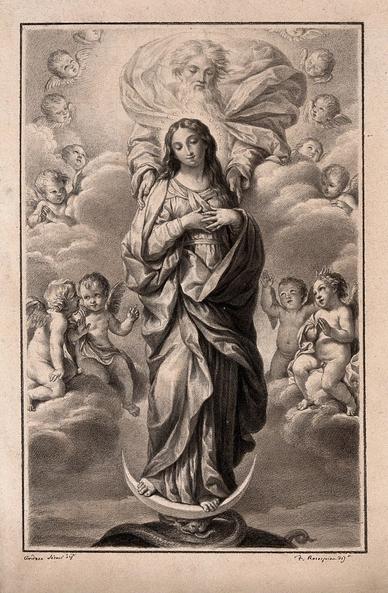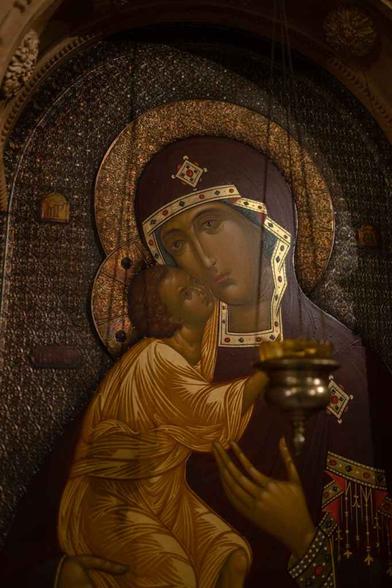The Assumption of the Virgin Mary
This is 1 of the 4 Marian dogmas of the Catholic Church. Pope Pius XII gave its definition on November 1, 1950 with his apostolic constitution named Munificentissimus Deus as the Assumption of Mary, body & soul, into Heaven. It’s celebrated on August 15th.
Munificentissimus Deus mentions several Holy Fathers, theologians, & Doctor of the Church who held to the Assumption of Mary are: Adrian I, Sergius I, Leo IV, John of Damascus, Amadeus of Lausanne, Modestus of Jerusalem, Anthony of Padua, Albertus Magnus, Thomas of Aquinas, Bonaventure, Bernardino of Siena, Robert Bellarmine, Francis de Sales, Peter Canisius, Francisco Suarez, etc.
It’s debated between theologians, clergy, & laypeople whether Mary actually died or whether she was raised up to eternal life without bodily death.
In Eastern Christianity, they have an equal belief called the Dormition of the Mother of God, or the “Falling Asleep of the Mother of God.” In Lutheran churches, August 15 is celebrated as the Feast of St. Mary. Some Anglican denominations observe August 15 under a variety of names, including the Feast of St. Mary the Virgin or the Falling Asleep of the Blessed Virgin Mary.
In the Passing of the Blessed Virgin Mary, this is credited to Joseph of Arimathea, 1 of the apostles (often pictured as Thomas the Apostle, of Doubting Thomas fame), wasn’t there at the time of Mary’s death. But he gets there late. This brought about a reopening of Mary’s tomb. Only Mary’s grave clothes were found in the empty tomb. Just like her son, Jesus. Subsequently, Mary drops her girdle down to the apostles, from Heaven, as proof of the event happening.
The feast was commanded for Constantinople on August 15 by Emperor Maurice in 600. About 50 years later, it was introduced in Rome & is mentioned in a papal decree of Sergius (687-701), who started a procession for the feast.
Pope Leo IV gave the feast a vigil & an octave to solemnise it above all others. An octave is the 8th day after a church festival, including the day of the festival. Pope Nicholas I placed it on a par with Christmas & Easter. On November 1, 1950, Pope Pius XII declared the Assumption of the Virgin Mary as a dogma of faith.
In the 12th century, a German nun Elisabeth of Schonau was allegedly granted visions of Mary & Jesus. This had a far-reaching influence on the Western Church’s tradition. In her work Visio de resurrectione beaten Virginia Mariae, she tells how Mary was assumed in body & soul into Heaven.
On May 1, 1950, Gilles Bouhours, who was a Marian seer, reported to Pope Pius XII a supposed message that the Virgin Mary would have ordered him to tell the Pope on the dogma of the Assumption of the Holy Virgin Mary.
It’s said that Pius XII asked God for a sign that could reassure him that the dogma of the Assumption of the Virgin Mary was ACTUALLY wanted by God. This just happened to be during the Holy Year of 1950.
When Gilles communicated the message to Pius XII, the Pope considered this message the hoped for granted to Gilles by the Pope. Pius XII himself said the dogma of the Assumption of the body & soul of the Blessed Virgin Mary into Heaven.
Some Catholics believe that Mary passed away before being assumed. But they believe that she was miraculously resurrected before being assumed. This is a moralistic interpretation. Others believe she was assumed bodily into Heaven without dying first. This is an immoralistic interpretation. Either interpretation can be held legitimately by Catholics, with Eastern Catholics observing the Feast as the Dormition.
The Feast of the Assumption of the Blessed Virgin Mary is celebrated in the Roman Catholic Church on August 15th. The Eastern Orthodox & Eastern Catholics celebrated the Dormition of the Mother of God on this date. This is also called the Dormition of the Theotokos, the “falling asleep of the Mother of God. It’s preceded by a 14-day period of fasting.
Eastern Christians believe Mary died a natural death, that he soul was received by Christ upon death, that her body was resurrected after her death, & that she was taken up into a Heaven bodily in anticipation of the general resurrection.
Views differ within Protestantism. They are those with a theology closer to Catholicism sometimes believing in a bodily assumption. Most Protestants don’t believe this.
The Lutheran Church kept the Feast of the Assumption of Mary after the Reformation. They designated August 15th as a lesser festival named “Mary, Mother of Our Lord” or “St. Mary, Mother of our Lord.”
While in Anglicanism, the Assumption of Mary is accepted by some & rejected by others. It disappeared from Anglican worship in 1549. It partially returned to Anglo-Catholic tradition during the 20th century under different names.
A Marian feast on August 15th is celebrated by the Church of England as a non-specific feast of the Blessed Virgin Mary. This feast is called by the Scottish Episcopal Church it’s a feast called “St. Mary the Virgin.” Other Anglican provinces have a feast of the Dormition. The Anglican Church of Canada’s Book of Common Prayer (1962) marks the day as the “Falling Asleep of the Blessed Virgin Mary.”
Assumption Day on August 15th is a nationwide public holiday in Andorra, Austria, Belgium, Burundi, Cameroon, Central African Republic, Chile, Republic of Congo, Cote d’Ivoire, Croatia, Colombia, Costa Rica, Cyprus, East Timor, France, Gabon, Greece, Georgia (the country), Republic of Guinea, Haiti, Italy, Lebanon, Liechtenstein, Lithuania, Luxembourg, Republic of North Macedonia, Madagascar, Malta, Mauritius, Monaco, Montenegro (Albanian Catholics), Paraguay, Philippines (Maragondon, Cavite), Portugal, Romania, Rwanda, Senegal, To go, Seychelles, Slovenia, Spain, Syria, Tahiti, & Vanuatu. It was also in Hungary until 1948.
It’s also a public holiday in parts of Germany (parts of Bavaria & Saarland), Switzerland (in 14 of 26 countries), & Bosnia & Herzegovina. In Guatemala, it is observed in Guatemala City & the town of Santa Maria Nebaj. Both cities claim her as their patron saint. In Costa Rica & parts of Belgium, the day is combined with Mother’s Day.
Prominent Catholics, Eastern Orthodox, & Oriental Orthodox countries in which Assumption Day is an important feast day but isn’t a public holiday recognized by the state include the Czech Republic, Ireland, Mexico, the Philippines, & Russia. In Bulgaria, the Feast of the Assumption is the biggest Eastern Orthodox celebration of the Holy Virgin. In Eastern Orthodox churches following the Julian Calendar, the feast day falls on August 28th.
In the Maronite church, the Assumption of Mary is known as the “Assumption of the Holy Mother of God.” It’s celebrated on August 15th.
One-Time Monthly YearlyMake a one-time donation
Make a monthly donation
Make a yearly donation
Choose an amount
$1.00 $5.00 $10.00 $1.00 $5.00 $10.00 $5.00 $10.00 $15.00Or enter a custom amount
$Your contribution is appreciated.
Your contribution is appreciated.
Your contribution is appreciated.
DonateDonate monthlyDonate yearly
#1May1950 #1November1950 #12thCentury #1549 #1948 #1950 #1962 #20thCentury #600 #687 #701 #AdrianI #AlbanianCatholics #AlbertusMagnus #AmadeusOfLausanne #Andorra #AnglicanChurch #AnglicanCommonPrayer #Anglicanism #AngloCatholic #AnthonyOfPadua #ApostolicConstitution #AssumptionOfMary #August15 #August28 #Austria #Bavaria #Belgium #BernardinoOfSiena #BlessedVirginMary #Bonaventure #BosniaHerzegonvina #Bulgaria #Cameroon #Cantons #CatholicChurch #Catholicism #Catholics #Cavite #CentralAfricanRepublic #Chile #Christmas #ChurchOfEngland #Constantinople #CostaRica #CoteDIvoire #Croatia #CzechRepublic #DoctorOfTheChurch #Dormition #DormitionOfTheMotherOfGod #DormitionOfTheTheotokos #DoubtingThomas #Easter #EasternCatholics #EasternChristianity #EasternOrthodoxChurch #EmperorMaurice #FallingAsleepOfTheBlessedVirginMary #FallingAsleepOfTheMotherOfGod #fasting #FeastOfStMary #FeastOfStMaryTheVirgin #FeastOfTheAssumption #FeastOfTheAssumptionOfTheBlessedVirginMary #FrancisDeSales #FranciscoSuarez #Gabon #Georgia #Germany #GillesBouhours #Greece #Guatemala #GuatemalaCity #Haiti #HolyVirgin #HolyVirginMary #HolyYearOf1950 #Hungary #Ireland #Italy #Jesus #JohnOfDamascus #JosephOfArimathea #JulianCalendar #Lebanon #LeoIV #Liechtenstein #Lithuania #LutheranChurch #Luxembourg #Madagascar #MarianDogmas #MaroniteChurch #MaryMotherOfOurLord #Mauritius #Mexico #ModestusOfJerusalem #Monaco #Montenegro #MotherSDay #MunificentissimusDeus #Paraguay #PassingOfTheBlessedVirginMary #PeterCanisius #Philippines #Poland #PolishArmyDay #PopeLeoIV #PopeNicholasI #PopePiusXII #Portugal #Protestantism #Protestants #Reformation #RepublicOfCongo #RepublicOfGuinea #RepublicOfNorthMacedonia #RobertBellarmine #RomanCatholicChurch #Romania #Rome #Russia #Rwanda #Saarland #SantaMariaNebaj #ScottishEpiscopalChurch #Senegal #Sergius #SergiusI #Seychelles #Slovenia #Spain #StMaryMotherOfOurLord #StMaryTheVirgin #StMaryTheVirginMotherOfOurLordJesusChrist #Switzerland #Syria #Tahit #Tahiti #ThomasOfAquinas #ThomasTheApostle #Togo #Vanuatu #VirginMary #VisioDeResurrectioneBeatenVirginiaMariae #WesternChurch





